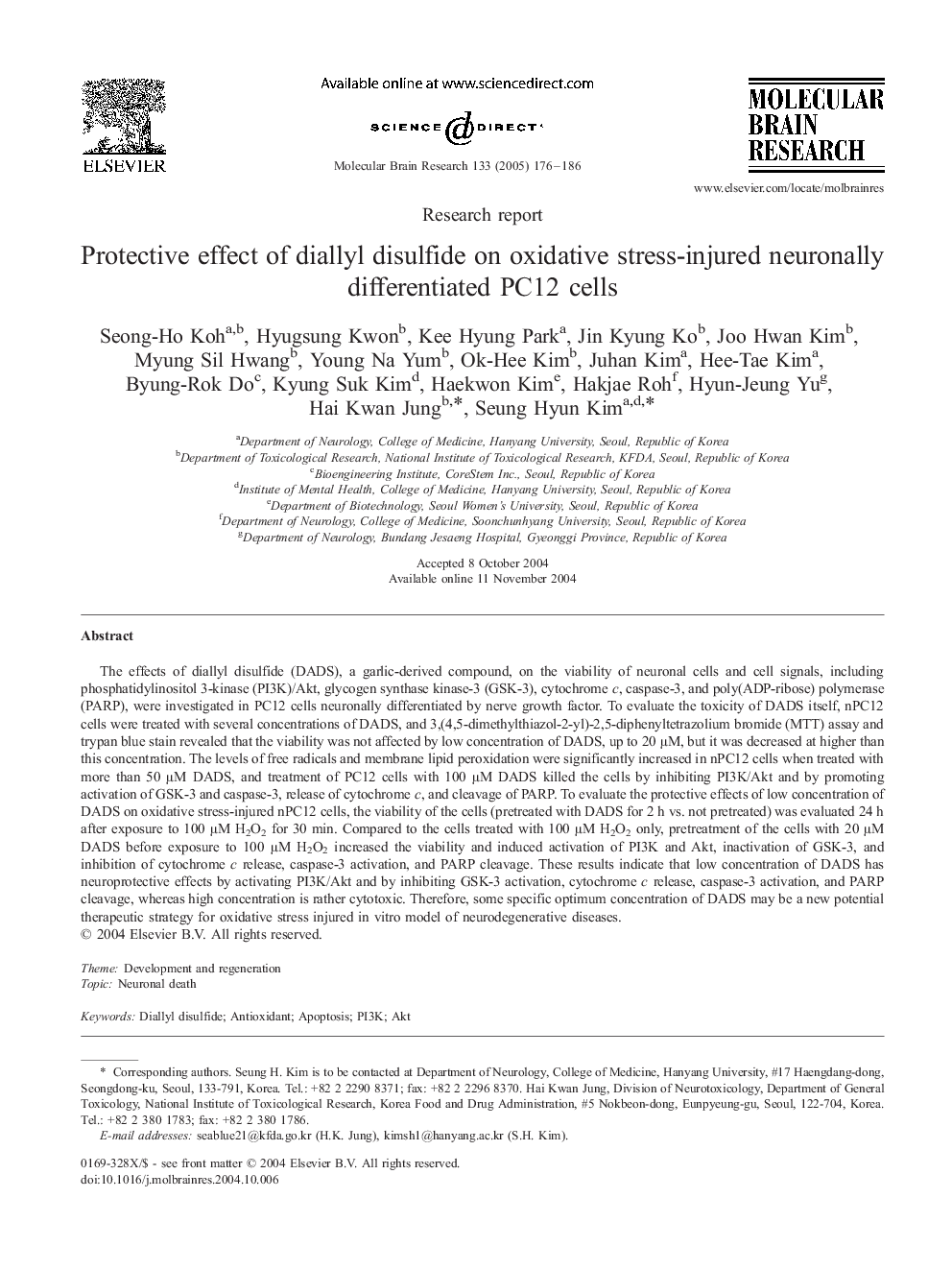| کد مقاله | کد نشریه | سال انتشار | مقاله انگلیسی | نسخه تمام متن |
|---|---|---|---|---|
| 9410792 | 1291275 | 2005 | 11 صفحه PDF | دانلود رایگان |
عنوان انگلیسی مقاله ISI
Protective effect of diallyl disulfide on oxidative stress-injured neuronally differentiated PC12 cells
دانلود مقاله + سفارش ترجمه
دانلود مقاله ISI انگلیسی
رایگان برای ایرانیان
کلمات کلیدی
موضوعات مرتبط
علوم زیستی و بیوفناوری
علم عصب شناسی
علوم اعصاب سلولی و مولکولی
پیش نمایش صفحه اول مقاله

چکیده انگلیسی
The effects of diallyl disulfide (DADS), a garlic-derived compound, on the viability of neuronal cells and cell signals, including phosphatidylinositol 3-kinase (PI3K)/Akt, glycogen synthase kinase-3 (GSK-3), cytochrome c, caspase-3, and poly(ADP-ribose) polymerase (PARP), were investigated in PC12 cells neuronally differentiated by nerve growth factor. To evaluate the toxicity of DADS itself, nPC12 cells were treated with several concentrations of DADS, and 3,(4,5-dimethylthiazol-2-yl)-2,5-diphenyltetrazolium bromide (MTT) assay and trypan blue stain revealed that the viability was not affected by low concentration of DADS, up to 20 μM, but it was decreased at higher than this concentration. The levels of free radicals and membrane lipid peroxidation were significantly increased in nPC12 cells when treated with more than 50 μM DADS, and treatment of PC12 cells with 100 μM DADS killed the cells by inhibiting PI3K/Akt and by promoting activation of GSK-3 and caspase-3, release of cytochrome c, and cleavage of PARP. To evaluate the protective effects of low concentration of DADS on oxidative stress-injured nPC12 cells, the viability of the cells (pretreated with DADS for 2 h vs. not pretreated) was evaluated 24 h after exposure to 100 μM H2O2 for 30 min. Compared to the cells treated with 100 μM H2O2 only, pretreatment of the cells with 20 μM DADS before exposure to 100 μM H2O2 increased the viability and induced activation of PI3K and Akt, inactivation of GSK-3, and inhibition of cytochrome c release, caspase-3 activation, and PARP cleavage. These results indicate that low concentration of DADS has neuroprotective effects by activating PI3K/Akt and by inhibiting GSK-3 activation, cytochrome c release, caspase-3 activation, and PARP cleavage, whereas high concentration is rather cytotoxic. Therefore, some specific optimum concentration of DADS may be a new potential therapeutic strategy for oxidative stress injured in vitro model of neurodegenerative diseases.
ناشر
Database: Elsevier - ScienceDirect (ساینس دایرکت)
Journal: Molecular Brain Research - Volume 133, Issue 2, 18 February 2005, Pages 176-186
Journal: Molecular Brain Research - Volume 133, Issue 2, 18 February 2005, Pages 176-186
نویسندگان
Seong-Ho Koh, Hyugsung Kwon, Kee Hyung Park, Jin Kyung Ko, Joo Hwan Kim, Myung Sil Hwang, Young Na Yum, Ok-Hee Kim, Juhan Kim, Hee-Tae Kim, Byung-Rok Do, Kyung Suk Kim, Haekwon Kim, Hakjae Roh, Hyun-Jeung Yu, Hai Kwan Jung, Seung Hyun Kim,